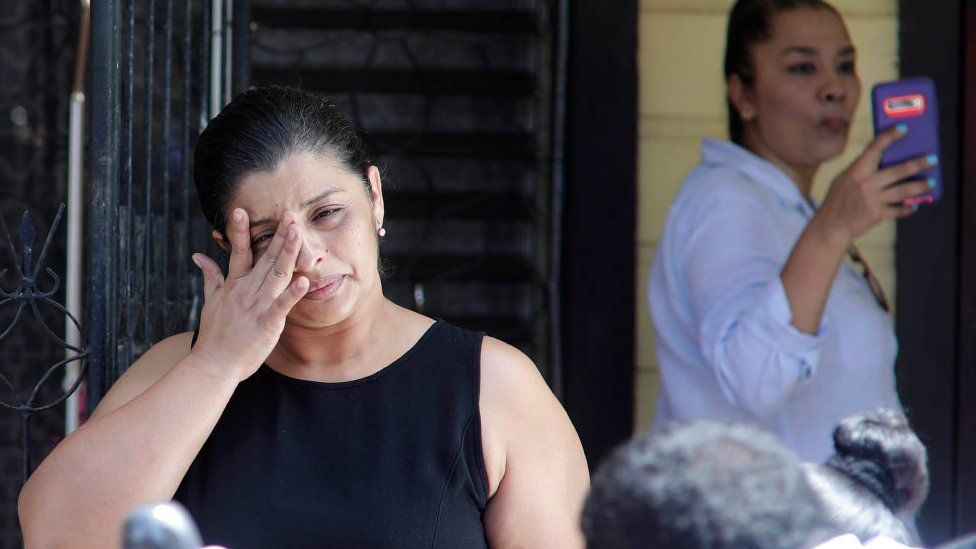ARTICLE AD BOX
By Valentina Oropeza Colmenares
BBC Mundo, Miami
 Image source, Getty Images
Image source, Getty Images
Karen Italian Caballero, the mother of two teenage Honduran victims, wipes away tears as she speaks to local media
It was 25 June when Karen Caballero was seized by an "unexplained heaviness" in her chest. Her children had not been in touch.
Two days later, around 20:00 at night, she received a news alert on her cell phone.
Dozens of migrants had died of heat inside the back of an abandoned lorry near the city of San Antonio, Texas, a few hundred miles from the US-Mexico border.
Panicked, Ms Caballero searched Google and Facebook for the phone numbers of Honduran consulates in the US, hospitals and police stations, to find out if her two sons and daughter-in-law could be among the victims.
It was 02:00 in the morning and no one was answering.
It has since emerged that Margie Paz Grajera, 24; Alejandro Andino Caballero, 23; and Fernando Redondo Caballero, 18 - Ms Caballero's relatives - were among the 53 migrants who died inside the lorry transporting 62 people from Mexico, Guatemala, El Salvador and Honduras.
They died locked inside a trailer with no ventilation as temperatures reached a sweltering 100F (40C).
Speaking to the BBC, Ms Caballero asked: "How, being such an over-protective mother, could I let this happen to my children?"
"If my children did not return at 20:00 at night, I was capable of walking out to look for them until I brought them home."
She has not even had the time to cry, she says, overwhelmed by phone calls from so many family members, friends and journalists.
Image source, EPA
Image caption,Magdalena Tepaz - whose son Wilmer Tulul, 14, died in Monday's accident - arrives at the Guatemalan Foreign Ministry to recover his body
But "anyone who thinks: 'This woman does not hurt, this woman does not suffer'," is wrong, she said.
"The truth is that I have to stay strong because I have to figure this out. As a mother, I still have to bring my children home."
Since the gruesome discovery of the worst migrant smuggling tragedy in modern US history earlier this week, the identities of some of the 53 dead in a truck in San Antonio have started to trickle out.
They paint a picture of mostly impoverished people from across the region looking to start afresh and seek new opportunities.
Mexican authorities said Wednesday that a total of 67 migrants were inside the lorry, while prosecutors in San Antonio have put the number at 64.
On Wednesday, the Bexar County medical examiner's office said it had "potential identifications" for most of the 53 victims from Monday's incident.
The victims have so far included 27 Mexican citizens, as well as 14 Hondurans, seven Guatemalans and two Salvadorans.
But because it must work with consulates and other foreign entities, the medical examiner's office said it has so far not made any "conclusive identifications".
"A false identification has consequences," Tom Peine, a spokesman for the office, told the BBC. "We are taking great care of this process".
Image source, Facebook
Image caption,Fernando Redondo Caballero, Alejandro Andino Caballero and Margie Paz were among those who perished
Of those who died, 40 were male and 13 were female.
Ms Caballero's son Alejandro, his wife Margie, and his brother Fernando, left for the US together from Las Vegas, in north-western Honduras.
The young couple met when they studied together at an Adventist school in Las Vegas de Santa Bárbara, a town 125 miles from the Honduran capital of Tegucigalpa, Ms Caballero said.
"They got married in the school wedding, with paper rings. They were 17 and 18 years old," she said.
Margie went on to study economics at the Autonomous University of Honduras, and Alejandro enrolled in marketing at the University of San Pedro Sula.
Every day they traveled more than 60 miles (100km) from their village to San Pedro Sula, several hours away by bus, to get to the first lessons on time.
They stayed in San Pedro Sula to look for jobs, but the best they could find was working as operators in a call centre, Ms Caballero said.
She recalled how the young couple celebrated when they bought their first refrigerator. Each appliance, each piece of furniture, reinforced the conviction that they had made the right decision to study at university and dedicate themselves to building a professional career, she said.
However, salaries diminished amid economic difficulties driven by the Covid-19 pandemic, and they could not cover rent. They "had dreams as a couple, they had goals," but were unable to find work despite receiving academic degrees, she said.
Image source, Cuenta personal en Facebook
Image caption,Margie Paz Grajeda studied economics in San Pedro Sula.
The family's finances worsened, and Ms Caballero's youngest son, Fernando, was forced to drop out of school amid the lockdown.
He told her: "Imagine mummy, if there are no jobs here for those who study, what will become of me having not studied?"
He had determined that he would go to the US, she said. Initially, he planned to travel alone, but his older brother and sister-in-law agreed to accompany him.
The three collected money from family and looked for people who could get them to the US, as they had no visa, though Ms Caballero would not reveal further details of their planning.
She took a taxi to Guatemala with her sons and daughter-in-law to say goodbye. They toured the city of Antigua before continuing on to Mexico.
For 20 days they communicated with Ms Caballero through Whatsapp to update her on the news of the trip before losing touch.
Questions remain over the identities and circumstances surrounding the deaths of the migrants smuggled alongside Ms Caballero's kin.
Three people have been arrested in connection to the operation, and a US federal investigation is underway.
Among those who have been provisionally identified among the victims is another Honduran national, Adela Betulia Ramirez, 28, who left the small beach town of Omoa on 26 May, according to her cousin.
Image source, Getty Images
Image caption,Family members of Melvin Guachiac, a 13-year-old Guatemalan who died
She planned to travel to Los Angeles, where her fiancé, mother and siblings live.
Two Guatemalan boys, aged 13 and 14, were also among those to have perished, officials from their home country announced on Wednesday.
Pascual Melvin Guachiac and Juan Wilmer Tulul were cousins who left home two weeks ago in order to escape poverty, Pascual's mother was quoted in Guatemalan media as saying.
On Monday, just hours before the lorry was discovered abandoned, the teenage relatives had told their family they were headed for San Antonio.
Among those who narrowly survived the deadly voyage was Jose Luis Vasquez Guzman, a 31-year-old who began his journey to the US from Cerro Verde, a remote farming community in southern Oaxaca state, in Mexico.
An army vet, Mr Guzman suffered dehydration inside the lorry discovered in San Antonio on Monday. He is now being treated at a local hospital.
Oaxaca's government is said to be seeking a humanitarian visa for Mr Guzman's mother so she can be by her son's bedside in hospital.
The injured migrant is said to have travelled to the US border with his cousin, Javier Flores Lopez, whose whereabouts are not currently known.
The Cerro Verde region has little to no cell phone service, and family members typically must travel to the town of Nochixtlan, some 37 miles away, to seek information on migrant relatives.
Image source, Handout
Image caption,Pascual Melvin Guachiac and Juan Wilmer Tulul, who were cousins from Guatamala
Mr Lopez called on 19 June to say he had crossed into the US and was hiding in a house in Texas, but he has not been heard from since.
'They lied to us'
Some expressed surprise at their relatives' fates, despite the well-known dangers of the border.
Among them was Noel Díaz, a US-based Mexican who on Wednesday was at the Mexican consulate in San Antonio working to repatriate his brother's remains to their native Oaxaca.
"The people who were bringing him lied to us," Mr Diaz told Mexico's El Universal outlet.
"They never said that he was there [in the truck], but with the news we imagined it. He was supposed to come more comfortably."
Josué Díaz leaves behind a wife and son.
Ms Caballero still does not know when the bodies of her sons and daughter-in-law will be repatriated to Honduras.
While talking to the BBC, she received a call. "It's from the presidential palace," she said. "I'll call you back".
Additional reporting by Bernd Debusmann and Sam Cabral

 2 years ago
49
2 years ago
49








 English (US) ·
English (US) ·